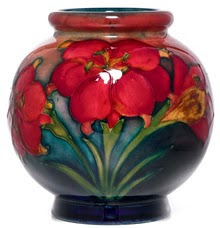 |
| Moorcroft History |
The distinctive and stylish products of Moorcroft Pottery stand out today as the best examples of English Art Nouveau pottery produced during the early years of the 20th century on wards. The patterns used slip trailing' to create the intricate and complex designs that used trees, flowers and fruits for inspiration.
The Moorcroft Pottery was established in 1913, in Stoke-on-Trent by William Moorcroft, whose family had been associated with the production of pottery for many years.
He started his career when he was offered a position as designer at James Macintyre & Co., established in 1852.
 |
| Moorcroft History |
When William Moorcroft was promoted to the position of Manager of the Ornamental Ware, following the departure of Harry Barnard who had introduced slip trailing (tube lining), he had complete control over production and began creating some of the most outstanding decorative art wares such as Florian Ware, which included a range of different patterns that used butterflies, flowers, peacock feathers, fish, daffodils and cornflowers for inspiration.
 |
| Moorcroft History |
The range, introduced in 1901, was sold in Liberty's of London and Tiffany's in New York, and was one of the company's earliest successes. This pattern inspired others such as Hazledene, Clarernont and Hisperiav. These distinctive wares afforded James Macintyre & Co. international acclaim at the important world expositions including the St Louis World's Fair in 1904 where they won a gold medal. Despite this success, the company decided to close down the Ornamental Department and concentrate on other production.
As a result, William Moorcroft decided to set up his own factory at Cobridge which he moved into in 1913 with financial support form Liberty and Co., based in London. They also advised him to introduce a range of tablewares that resulted in a range finished with a blue speckled pattern that, they called Powder Blue and sold through their prestigious store from 1913. It was such a critical and commercial success that it remained in production until the early-1960s.
 |
| Moorcroft History |
William Moorcroft responded to changes in customer taste and produced a range of exciting and bold flambe glazes which he used on patterns such as Orchid and Freesia as well as several of his earlier designs including Claremcmt, that featured toadstools motifs, and Hazledene. A number of his designs featured landscape designs including Moonlit Blue and Dawn from 1926.
Following the economic setbacks after the Wall Street Crash in 1929 the company, alongside other manufacturers, suffered financially and it led to a change in style. His son Walter joined the company in 1935.
William Moorcroft died in 1945 leaving his son to run the business. Following WW2 Walter Moorcroft created several new patterns based on foreign flowers especially exotic with typical patterns such as Arum Lily in, Campanula and Tulip. Some patterns, such as Leaves in the Wind, were in production for a short period whilst the Pansy Nouveau was made for the American market, c. 1972.
 |
| Moorcroft History |
The best examples of Moorcroft pottery, now over 100-years-old, still have the richness and freshness that they had when they were first fired in the kilns. Furthermore, they haven't dated at all and have transcended the many fashions and fads that came and went throughout the 20th century.
Collectibles Coach

No comments:
Post a Comment